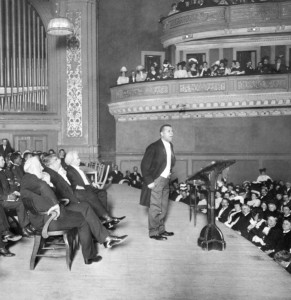By Jack El-Hai, Wonders & Marvels contributor
Over the past twenty years, I’ve given talks about history — usually on topics connected to the subjects of my books — throughout North America and in Europe. Most of my talks have taken place in undergraduate and graduate-level academic settings, although I’ve also addressed medical and history conferences, schoolchildren, business audiences, book clubs, and cultural groups.
Talking about history is an acquired skill. I’ve grown adept at making quick adjustments for the needs and interests of the audience as well as for the quirks of the setting. For those of you contemplating a history talk, I offer these five tips:
- Arrive early — not just to avoid being late, but also to take in what’s preceding your talk. If other speakers are giving talks before yours, you’ll do your audience a service if you can link your topic with those of the earlier speakers. Much of understanding history, after all, is about connecting the dots. Help your audience make illuminating connections.
- Don’t read. Book authors often believe that they must read out loud from their pages, but doing so puts people to sleep. Audiences, who are often as interested in learning about you as your writing, want to understand your historical obsessions. Let the book speak for itself and give the audience an intriguing story about your path to writing it. When I talk about The Nazi and the Psychiatrist, I often tell the tale of how I found the documents upon which I based the book.
- Avoid unclear language. The study of history is full of jargon favored by specialists or indicative of lazy thinking. Don’t use it. I make a point of eliminating from my talks the terms I call “The Evil I’s” — the various forms of the words impact, inform, and issue — in the interests of clarity and directness. You can form your own hit list of terms.
- Customize your talk. Speaking to a conference of neurosurgeons about my book The Lobotomist, for example, I focus on the historical developments in brain surgery that accompanied lobotomy. Business audiences are intrigued by the speculations of Dr. Douglas M. Kelley — the central figure in The Nazi and the Psychiatrist — on the similarities between the Nazi leadership hierarchy and the organization of corporations.
- Let your audience teach. We all know to ask for questions from the audience, but a skilled history speaker will go further by directing questions to the audience. A standard feature of my talks about The Lobotomist and the history of psychosurgery is my call for stories from the audience about their experiences with psychiatric surgery. People have risen to give the most amazing personal accounts — many of which I wish I could have included in my book — and one person even displayed a set of lobotomy tools she had brought with her. (Her father was a psychosurgeon.)
Exemplary history talks:
Roach, Mary. 10 Things You Didn’t Know About Orgasm.
Skloot, Rebecca. The Immortal Life of Henrietta Lacks.

